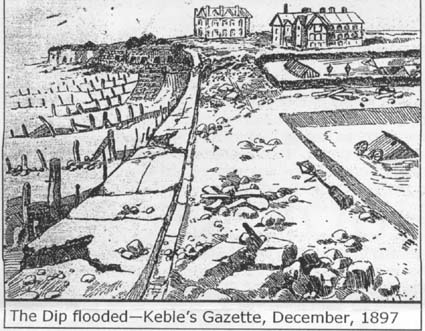 Birchington
Heritage Trust - Newsletter
Birchington
Heritage Trust - Newsletter  Birchington
Heritage Trust - Newsletter
Birchington
Heritage Trust - Newsletter
By
Colin Gordine
The 'Dip', lying on the coast
of Minnis Bay
between Canute Road and Minnis Road, along with the surrounding
low-lying areas
of built up land, is a surviving remnant of the Gore Creek which once
stretched
inland as far as Upper Gore End Farm.
The shelter from the northerly winds provided by the
now eroded hook of
cliffs provided a safe haven for boats and settlements dating from the
the
Bronze Age, through Roman and Anglo-Saxon times (ref: the Beck
excavations
1938) until the mid 19th Century. Many older locals will remember the
old
coastguard boathouse which was demolished to make way for the flats at
the
junction of Minnis and Ethelbert Roads. The Creek gradually silted up over the centuries becoming little more than a tidal marsh by the mid-19th Century. In 1880, the Birchington Bay Estate Company finally sealed off the inlet with the construction of a sea wall, now known as 'The Parade'. The land to the south of the Dip (formerly known as Athelstan Gardens) as far as Dane Road, and the area to the east, now housing the children's play area, was reclaimed using spoil from local building work and refuse collected from the streets of Margate. Tennis courts were to be provided in the Dip as well as a small exhibition hall, tea pavilion and greenhouses, within a sunken garden. The exhibition hall, a large barn-like structure, was funded by the Estate managing director, Mr Rayden, a London stockbroker, to display a “loan exhibition, fancy, fair and horticultural show”, no doubt with an eye to publicity for the Estate. The perimeter was planted with hedges to provide protection from the winds. Unfortunately these hedges did little to prevent the destruction of the buildings in the great storm of 29th November 1897.  Rebuilding of the
greenhouses followed and the gardens were restored to their former
glory. A
'Tea Garden' was created amongst the plants.
Run by the Johnson family (owners of the Minnis Bay
Post Office), this
proved be a popular attraction between the Wars. Unfortunately the Second
World War curtailed all these activities and by its end, all that
remained of
the sunken gardens were the perimeter hedges and a small concrete base
which
supported the Tea Garden kitchens.
A
part of this can still be seen today beneath the grassy slope into the
Dip
opposite Viking Close. In the storm of January 31st 1953, the exceptionally high spring tide, coupled with north-westerly gales and heavy rain, flooded across the road and into the surrounding low-lying land, including the Dip, filling it to the level of the road surface. It took many weeks for the waters to subside and even longer for the grass to recover from its salty soaking.
The Dip has remained an
open play area to this day, providing some shelter from the northerly
gales for
summer visitors and residents alike. However, from time to time, when
there is
heavy rain and when a storm force 10 is hurling its sea spray across
The
Parade, the former Gore Creek seems to be making an attempt to recover
its lost
route to the sea. |